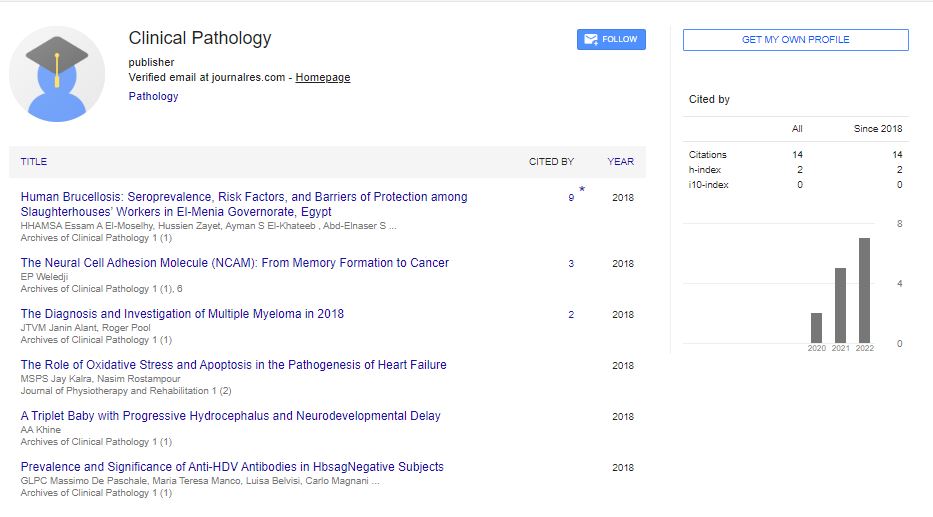Opinion Article, Arch Clin Pathol Vol: 7 Issue: 1
Impact of Cytopathology in Cancer Screening and Diagnosis
Michael Tawil*
Department of Pathology, Kocaeli University, Kocaeli Turkey
*Corresponding Author: Michael Tawil
Department of Pathology, Kocaeli University, Kocaeli Turkey
E-mail: susankobie@glh71.edu
Received date: 20 February, 2023, Manuscript No. ACPY-23-93124;
Editor assigned date: 22 February, 2023, PreQC No. ACPY-23-93124 (PQ);
Reviewed date: 09 March, 2023, QC No ACPY-23-93124;
Revised date: 16 March, 2023, Manuscript No. ACPY-23-93124 (R);
Published date: 23 March, 2023, DOI: 2324-8955/acpy.05.03.100074
Citation: Tawil M (2023) Impact of Cytopathology in Cancer Screening and Diagnosis. Arch Clin Pathol 6:1.
Description
Cytopathology is the branch of pathology that deals with the study of cells obtained from various body sites through non-invasive or minimally invasive techniques. The examination of cells at the microscopic level can reveal changes indicative of disease, including cancer. The field of cytopathology plays a essential role in the diagnosis of various diseases, including cancer. The primary application of cytopathology is in cancer screening and diagnosis. Regular screening for cancer helps to detect the disease in its early stages, which greatly improves the chances of successful treatment. Cytopathology-based cancer screening tests are non-invasive and can detect the presence of cancer cells before the onset of any symptoms. The most common cancer screening test that uses cytopathology is the Pap test, which is used to detect cervical cancer. In the case of cancer diagnosis, cytopathology is used to analyze cells obtained through various methods, including Fine-Needle Aspiration (FNA), brushing, or washing. FNA involves the use of a thin needle to extract a small sample of cells from the tumor or the surrounding tissue. The cells are then examined under a microscope to determine whether they are cancerous or not. Brushing involves the use of a brush to collect cells from the lining of the organ or cavity, while washing involves flushing the organ with a fluid and collecting the cells. Cytopathology is used in the screening and diagnosis of cancer, particularly for cancers of the breast, thyroid, lung, and pancreas. It is also used in the diagnosis of other diseases, such as infections and inflammatory conditions.
Cytopathology is often used in conjunction with other diagnostic tests, such as imaging studies or laboratory tests. Another application of cytopathology is in the diagnosis of autoimmune disorders. Cytopathology can help identify cells and tissues that are being attacked by the immune system, leading to the development of autoimmune diseases. For example, the detection of antinuclear antibodies in cells obtained from body fluids is a major step in the diagnosis of Systemic Lupus Erythematosus (SLE). Immuno Cyto Chemistry (ICC) is another cytopathology method used to diagnose and manage diseases. It involves the use of antibodies to detect specific proteins or markers on the surface of cells. In ICC, a sample of cells is collected and placed onto a glass slide, and then specific antibodies are applied to the slide. The antibodies bind to the targeted protein or marker, and a chemical reaction occurs that produces a visible signal, such as a color change. This signal can then be detected and analyzed under a microscope. Flow cytometry is a cytopathology technique that involves the use of lasers to analyze and sort cells based on their physical and chemical characteristics. In flow cytometry, a sample of cells is passed through a laser beam, and the light scattered by the cells is detected and analyzed. The cells are then sorted based on their size, shape, and other properties. Flow cytometry is used in the diagnosis and management of various diseases, including leukemia and lymphoma. Cytopathology is also used in the diagnosis of metabolic diseases, such as lysosomal storage disorders. The detection of abnormal cells and tissues in body fluids can help identify the type of metabolic disorder present and guide the appropriate treatment. One of the major advantages of cytopathology is that it is a minimally invasive procedure that can be performed in an outpatient setting. This reduces the risk of complications and allows for faster recovery times. In addition, the results of cytopathology tests are often available within a few days, allowing for prompt diagnosis and treatment.
Conclusion
Clinical pathology plays a major role in enhancing diagnosis and patient care. It allows for the early detection of cancer, which greatly improves the chances of successful treatment. The field of clinical pathology is constantly evolving, with new technologies and techniques being developed to improve diagnosis and treatment outcomes. As such, clinical pathology is an essential component of modern medicine.
 Spanish
Spanish  Chinese
Chinese  Russian
Russian  German
German  French
French  Japanese
Japanese  Portuguese
Portuguese  Hindi
Hindi 